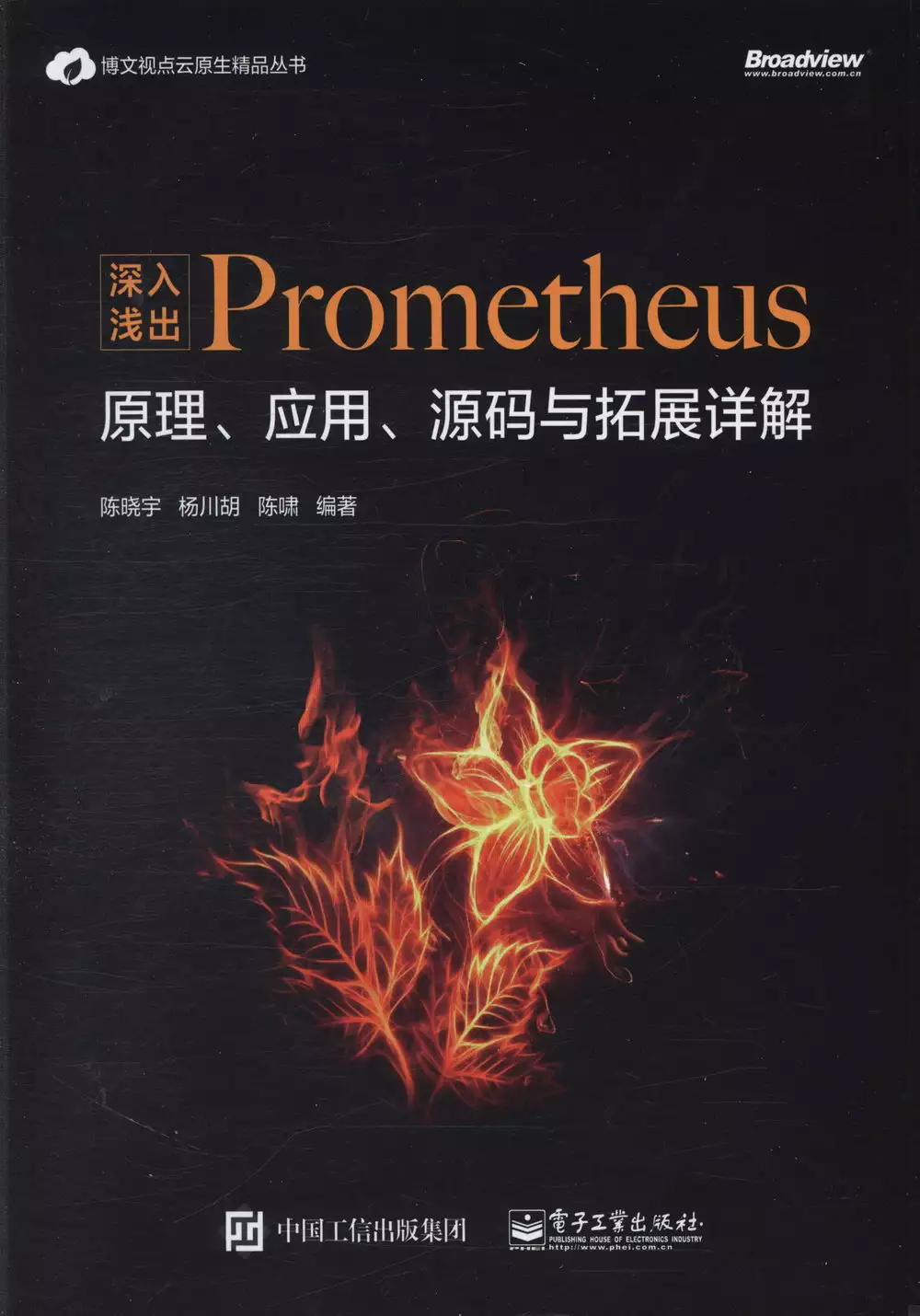Google APM的問題,我們搜遍了碩博士論文和台灣出版的書籍,推薦陳曉宇楊川胡陳嘯寫的 深入淺出Prometheus:原理、應用、源碼與拓展詳解 和StevenLevy的 Google總部大揭密:Google如何思考?如何運作? 如何形塑你我的生活?都 可以從中找到所需的評價。
這兩本書分別來自電子工業 和財信出版所出版 。
元智大學 管理碩士在職專班 丘邦翰所指導 余佩君的 中小企業數位轉型之研究 (2021),提出Google APM關鍵因素是什麼,來自於中小企業、企業轉型、數位轉型。
而第二篇論文國立臺北護理健康大學 護理研究所 林惠如所指導 NUR FITHRIYANTI IMAMAH的 The Perspectives of Palliative Care among End Stage Renal Disease Patients in Indonesia (2021),提出因為有 的重點而找出了 Google APM的解答。
深入淺出Prometheus:原理、應用、源碼與拓展詳解

為了解決Google APM 的問題,作者陳曉宇楊川胡陳嘯 這樣論述:
Prometheus是由SoundCloud開源的監控系統,是Google BorgMon監控系統的開源版本。伴隨著容器及Kubernetes技術的興起,Prometheus越來越受到大家的關注。《深入淺出Prometheus:原理、應用、源碼與拓展詳解》系統講解了Prometheus的原理、應用、源碼和拓展,圖文並茂、講解全面。原理篇主要介紹了Prometheus的整體架構及與其他監控系統的對比和優勢,讓讀者從整體上把握Prometheus的相關概念。應用篇從傳統應用監控和Kubernetes監控兩方面講解Prometheus的安裝、配置及優秀實踐,著重介紹Redis、MySQL serve
r等常用中間件監控,並結合Kubernetes,詳細講解如何通過Prometheus監控容器集群,還對每個操作都進行了非常詳盡的記錄。源碼與拓展篇從整體到局部詳細剖析Prometheus的源碼架構,並且結合實際生產環境二次定製Prometheus的部分功能,可加深讀者對Prometheus的理解,也能很好地幫助讀者提升Prometheus開發技能。 《深入淺出Prometheus:原理、應用、源碼與拓展詳解》適合運維工程師、軟體架構師、研發工程師及其他資深IT人士參考和閱讀。 陳曉宇,宜信容器雲架構師,負責宜信PaaS平台的設計和推廣,幫助企業從傳統應用遷移至雲原生應用
。在雲計算相關行業具有豐富的研發與架構經驗,並積极參与OpenStack、Kubernetes、Harbor等社區的開源項目。楊川胡,「k8s技術圈」社區維護者,全棧工程師,具備豐富的雲計算、上億活躍用戶應用後端實踐經驗,擅長Python、Golang、Docker、Kubernetes等技術,曾在小米擔任資深研發工程師。陳嘯,Prometheus二次開發深度使用者,專註于分散式搜索、流式計算、集群監控、大數據安全領域。現就職于深信服科技股份有限公司安全感知團隊,負責數據平台基礎架構研發工作。 第1篇 Prometheus原理 第1章 監控 2 1.1 監控系統概覽 2 1
.2 基礎資源監控 4 1.2.1 網路監控 4 1.2.2 存儲監控 6 1.2.3 伺服器監控 7 1.3 中介軟體監控 9 1.4 應用程式監控(APM) 10 1.5 日誌監控 13 1.6 監控系統實現 14 1.6.1 總體架構 14 1.6.2 指標採集 15 1.6.3 資料處理 18 1.7 監控系統的發展趨勢 21 1.8 本書主角——Prometheus 22 1.9 其他開源監控工具 26 1.9.1 Zabbix 26 1.9.2 Nagios 30 1.9.3 Open-Falcon 31 1.10 監控系統的對比 33 第2章 深入Prometheus設計 35
2.1 指標 35 2.1.1 Prometheus的指標定義 35 2.1.2 Prometheus的指標分類 36 2.1.3 Prometheus資料樣本 40 2.2 資料獲取 40 2.2.1 服務發現 42 2.2.2 資料獲取 44 2.3 資料處理 45 2.3.1 重新定義標籤 45 2.3.2 標籤篩選 46 2.4 資料存儲 46 2.4.1 本機存放區 47 2.4.2 遠端存放 50 2.5 資料查詢 50 2.6 告警 52 2.7 集群 54 2.7.1 聯邦 54 2.7.2 Thanos 55 2.8 Prometheus並非監控銀彈 59 第3章 資料存儲
60 3.1 存儲介面 60 3.2 本機存放區 62 3.2.1 歷史 63 3.2.2 核心概念 63 3.2.3 相關參數 69 3.2.4 本機存放區介面 70 3.3 遠端存儲 71 3.3.1 總體架構 71 3.3.2 遠端介面規範 71 3.3.3 相關參數 74 3.4 存儲彙聚 77 第2篇 Prometheus在傳統應用監控中的應用 第4章 Prometheus exporter詳解 80 4.1 服務分類 80 4.2 資料規範 81 4.3 exporter簡介 82 4.4 基於Go用戶端編寫一個exporter 84 4.5 Node exporter解析 87
4.6 Redis exporter解析 90 4.6.1 Redis exporter的應用 90 4.6.2 Redis exporter的工作原理 91 4.7 MySQL server exporter解析 93 4.7.1 MySQL server exporter的應用 93 4.7.2 MySQL server exporter的工作原理 94 4.8 深入探索Go用戶端 96 第3篇 Prometheus在Kubernetes監控中的應用 第5章 Kubernetes監控方案 100 5.1 Heapster 101 5.2 kube-state-metrics 104 5
.3 metrics-server 105 5.4 Prometheus 105 第6章 Prometheus的安裝配置 107 6.1 手動安裝Prometheus 107 6.2 安裝Prometheus Operator 114 6.3 在Prometheus Operator中添加自訂的監控項 125 6.4 在Prometheus Operator中添加自訂告警 132 6.4.1 配置PrometheusRule 133 6.4.2 配置告警 138 6.5 Prometheus Operator的高級配置 144 6.5.1 自動發現配置 145 6.5.2 資料持久化配置 15
2 第7章 Prometheus監控Kubernetes之服務配置 159 7.1 靜態配置 159 7.2 服務發現配置 164 第8章 Prometheus監控Kubernetes之監控對象 171 8.1 容器監控 172 8.1.1 Prometheus的配置方式 172 8.1.2 容器指標 174 8.2 apiserver監控 177 8.2.1 配置方式 177 8.2.2 apiserver指標 181 8.3 Service監控 182 8.4 kube-state-metrics監控 185 8.5 主機監控 186 第9章 Prometheus監控Kubernetes之
資料展現 191 9.1 在Kubernetes集群中安裝Grafana 191 9.2 配置Grafana 200 9.2.1 資料來源 200 9.2.2 Dashboard 201 9.3 外掛程式 207 9.4 Grafana告警 212 9.4.1 郵件告警 212 9.4.2 釘釘告警 214 9.4.3 Grafana告警配置 215 第10章 Prometheus監控Kubernetes之告警 219 10.1 AlertManager簡介 219 10.2 安裝AlertManager 220 10.3 告警規則 225 10.4 webhook接收器 231 第4篇 P
rometheus源碼與拓展 第11章 Prometheus服務元件 240 11.1 Prometheus源碼的目錄結構 240 11.2 原生Prometheus的不足 242 11.3 源碼改造——更改時區 243 11.3.1 源碼修改 243 11.3.2 編譯 244 11.3.3 功能驗證 244 11.4 源碼改造——用blog4go記錄系統日誌 245 11.4.1 引入blog4go庫 245 11.4.2 設置日誌回呼函數 246 11.4.3 開機記錄記錄服務 246 11.4.4 配置config.xml 247 11.4.5 編譯 248 11.4.6 驗證服務 2
48 11.5 Prometheus的初始化 248 11.5.1 Prometheus性能調試 249 11.5.2 Context介紹 249 11.5.3 初始化服務元件 251 11.5.4 元件配置管理 257 11.5.5 啟動服務元件 258 11.6 源碼改造——MySQL規則存儲 262 11.6.1 規則載入流程 262 11.6.2 表結構設計 262 11.6.3 規則載入模組 264 11.6.4 loadGroups改造 267 11.6.5 初始化 269 11.6.6 功能驗證 269 11.7 資料獲取 270 11.7.1 服務發現 270 11.7.2 指
標採集 277 11.7.3 存儲指標 289 11.8 通知管理 297 11.8.1 啟動notifier服務 298 11.8.2 註冊notifier 308 11.9 規則管理 311 11.9.1 規則調度 312 11.9.2 查詢引擎 321 11.10 源碼改造——不重複scrape及自帶時間戳記規則運算 327 11.10.1 實現思路 328 11.10.2 不重複scrape 328 11.10.3 自帶時間戳記規則運算 331 11.10.4 功能驗證 343 第12章 AlertManager服務元件 348 12.1 接收告警 348 12.2 告警調度 351
12.3 告警匹配 356 12.4 告警處理 357 12.5 告警通知 362
Google APM進入發燒排行的影片
本集主題:「亞流新世代APM」介紹
訪問:聖恩、紀瑤
聖恩,馬來西亞華僑,為了圓演藝夢所以選擇來台灣念大學,後來加入亞流,能說多國、多族語言,在信仰中也得到追夢的勇氣。
紀瑤,台科大英文系畢業,目前也有做影視演員工作,因為從小喜歡唱歌而決定加入亞流,目前是培訓主唱。
亞流新世代a.p.m:
由台灣師範大學亞流中心與達藝娱樂和樂手公園共同創立。
以栽培、訓練〈藝人〉或〈團體〉出道為目標。
粉絲頁: 亞流新世代a.p.m
#李基銘 #fb新鮮事 #生活有意思 #快樂玩童軍
#漢聲廣播電台
YouTube頻道,可以收看
https://goo.gl/IQXvzd
podcast平台,可以收聽
SoundOn https://bit.ly/3oXSlmF
Spotify https://spoti.fi/2TXxH7V
Apple https://apple.co/2I7NYVc
Google https://bit.ly/2GykvmH
KKBOX https://bit.ly/2JlI3wC
Firstory https://bit.ly/3lCHDPi
請支持六個粉絲頁
李基銘主持人粉絲頁:https://www.facebook.com/voh.lee
李基銘的影音頻道粉絲頁:https://www.facebook.com/voh.video
Fb新鮮事新聞報粉絲頁:https://www.facebook.com/voh.fbnews
漢聲廣播電台「fb新鮮事」節目粉絲頁:https://www.facebook.com/voh.vhbn
漢聲廣播電台「快樂玩童軍」節目粉絲頁:https://www.facebook.com/voh.scout
漢聲廣播電台「生活有意思」節目粉絲頁:https://www.facebook.com/voh.life
中小企業數位轉型之研究
為了解決Google APM 的問題,作者余佩君 這樣論述:
近年來數位科技迅速演進,新興的創意技術蘊含著無數商機及龐大的市場,數位技術成本的降低帶來了應用普及,因此逐漸改變世界整體的經濟環境型態。面對全球市場競爭與消費行為的改變,企業面對數位轉型的議題已是刻不容緩且迫在眉梢。轉型本來就不是容易的事,對於中小企業而言,是一個機會,是一個挑戰,更是極大的風險,卻是企業永續生存的必經之路。本研究主旨在探究中小企業數位轉型之議題,以臺灣中小企業為主要研究對象,透過深入訪談法研究訪談對象,深入探討研究對象在數位轉型前可能面臨的經營問題、轉型的困難、轉型對企業經營的影響。研究結果發現中小企業對於數位轉型抱持樂觀正向的態度,並期望藉由數位轉型改善內部作業流程效率、
加快訊息傳遞的即時性、提高品質的穩定度、提升客戶服務品質,以創造出新的最佳經營模式。
Google總部大揭密:Google如何思考?如何運作? 如何形塑你我的生活?

為了解決Google APM 的問題,作者StevenLevy 這樣論述:
AMAZON書店2011年「商業與投資類」好書第1名 第1本獲准進出Google總部長達兩年時間、參與多次內部會議 訪問數百位離職與現任員工而寫就的Google內幕! .Gmail、Android、Google雲端服務等超展開創新開發過程 .解開Google兩大黑箱之謎──搜尋引擎演進及廣告盈利模式 .Google在中國的道德難題與內部對中國政策的歧異 .Google將如何保持競爭優勢與創新優勢? AMAZON.《紐約時報》暢銷書.科技網站T客邦專文介紹 ∣如果有一天,Google的搜尋引擎突然故障 ∣GMAIL信件全數消失 ∣Google Maps、Googl
e Docs、Google行事曆等所有雲端服務全面停擺 ∣我們該怎麼辦?! 歷史上像Google如此成功,且廣受推崇的企業可沒幾家。它改變了網路的使用方式,也成了我們生活不可或缺的一部分。這到底是怎麼辦到的? 《連線》雜誌資深主筆史蒂芬.李維史無前例同時取得LSE三巨頭──佩奇(Larry Page)、布林(Sergey Brin)與施密特(Eric Schmidt)──之首肯,長達兩年多次進出Google總部,引領讀者一窺Google全貌。 Google創辦人佩奇和布林,早在史丹佛大學就讀時便掀起網路搜尋引擎革命。在改造搜尋引擎後,他們又推出另一傑出創新──徹底推翻傳統模式的網
路廣告。這讓Google賺進數十億美元。有了這個源源不絕的資金供應,Google才能大展身手,推動更多計畫,例如不斷精進的搜尋引擎、大容量電郵信箱Gmail、開放原始碼的Android系統、YouTube,以及Google Maps、Google Docs等雲端運算服務。 本書深入理解Google不同於多數大型企業的內在文化,發現Google之所以成功,主要來自該公司以工程師至上的「唯宅獨尊」思想。他們毫無歉意的菁英主義聘用策略,且不吝付出涵蓋食衣住行的優渥報酬,讓Google成為全世界最優秀電腦技客的群聚之地。同時Google亦嚴謹遵循某些網路價值,立志「不做邪惡的事」:講求速度、保持公
開、熱衷實驗、不怕冒險。 然而,Google這種「唯宅獨尊」、自由奔放的價值觀,反而讓他們在中國栽了個大筋斗。本書翔實記述Google進軍中國始末,揭示布林及同儕在中國策略上的不同主張。而在社交網站的進程上,目前也正以Google+ 奮力追趕Facebook──這在Google企業史上可是絕無僅有的頭一遭。如今有不少員工已經決定離開Google,轉向一些規模較小、但身段更靈巧的新興企業…… 過去發誓絕對不做邪惡大企業而名揚四海的Google,未來能否保持競爭優勢? 它現在是否正逐漸喪失創新優勢? 從來沒有任何一本書能像《Google總部大揭密》,能如此徹底揭露Google的過去、
現在與未來。 作者簡介 史蒂芬.李維STEVEN LEVY 長期關注Google已超過十年。李維曾是《新聞週刊》(Newsweek)資深編輯兼科技新聞主筆。現任《連線》(Wired)數位雜誌資深主筆。曾寫過和Apple有關的兩本著作──《Insanely Great》與《為什麼是 iPod?》(The Perfect Thing),以及經典之作《駭客:電腦革命的英雄》(Hackers)。現與妻兒住在紐約。 Website * www.StevenLevy.com 譯者簡介 陳重亨 淡江大學國貿系畢業,曾任《財訊快報》、《經濟日報》編譯,譯作散見於財信、皇冠、時報、遠流、臉譜等出版公
司。譯有《金錢實驗室的人性考驗》、《原物料投資一本通》、《我們相信聯準會》、《彼得林區征服股海》、《彼得林區選股戰略》、《投資心理學》等書(以上皆由財信出版)。
The Perspectives of Palliative Care among End Stage Renal Disease Patients in Indonesia
為了解決Google APM 的問題,作者NUR FITHRIYANTI IMAMAH 這樣論述:
The number of end-stage renal disease (ESRD) patients has been growing substantially worldwide; these patients generally have poor prognosis and require costly medical services. This pattern is also occurring in Indonesia. In western countries, palliative care originally developed for cancer patien
ts and has now extended to ESRD patients, but in Indonesia, palliative care for cancer patients remains limited and none is available for ESRD patients. If ESRD palliative care is to develop in Indonesia, we should consider how different cultures, religions, social values, health insurance statuses,
and differences within the health care system might affect the process of palliative care. This study explored perspectives about palliative care among patients with end-stage renal disease in Indonesia.This study used mix methods, combining descriptive study design, open-ended question and in-dept
h qualitative interviews. Purposive sampling was used to choose 222 participants for quantitative study based on the following inclusion criteria: ESRD patients on dialysis treatment at dialysis units at teaching hospitals in Indonesia, age ≥17 years old, who agreed to participate and signed informe
d consent. Patients with cognitive impairment, and acute kidney failure were excluded. The researcher conducted qualitative in-depth interviews with 30 of the 222 participants who decided to choose palliative care.Data for the quantitative study were obtained from a self-developed online questionnai
re using Google forms and were analyzed descriptively. Content analysis was used for the open-ended question on the questionnaire. In qualitative-in-depth-interview, the researcher conducted 30- to 45-minute online interviews using the latest version of the Zoom application with participants in priv
ate rooms. The interviewer recorded the entire interview process using her computer. Thematic analysis was then applied to the interview results to understand the experiences of deciding in receiving palliative care among ESRD patients in Indonesia.Participants were recruited from Lombok island and
Java island, parts of the largest islands in Indonesia. The majority of participants were 45 to 54 years old and were receiving dialysis twice a week for about 3 to 4 hours. Some participants had been newly diagnosed with ESRD and had done dialysis for about a month, whereas the longest duration of
dialysis was 16 years. Most used private transportation to go to the dialysis center with median time of 20 minutes. Male participants outnumbered female participants and most were married with median of two kids. The majority of participants lived with their families and were accompanied by family
to go to dialysis center. Participants with high school education made up the biggest proportion. Most had incomes below 36 USD (< IDR 500,000), but the range was not wide.Participants had limited information about palliative care for ESRD and thought that it should be offered to ESRD patients in In
donesia. When opportunity is available to receive ESRD palliative care, most participants showed willingness to receive it. Among participants, opinions about palliative care for ESRD differed. Some thought that they might benefit from palliative care while a few saw it as useless for their health.
Four themes and twelve subthemes emerged from qualitative study that provide deep description about the meaning of the participants’ decision to choose palliative care. The themes including patients’ considerations in choosing palliative care, building a closer relationship with family, a way to ach
ieve peaceful dying, and good for preparing the future.This study collected comprehensive information about ESRD patients’ perspectives on palliative care in Indonesia. Collaboration between educators, clinicians, and policy makers will be helpful to develop a model of palliative care for ESRD patie
nts in Indonesia. Furthermore, future researchers could develop intervention studies to improve patients’ and families’ knowledge regarding palliative care for ESRD in Indonesia.